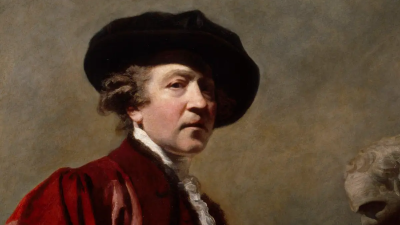
Michael Sandle RA, Head Mickey Mouse, 1978.
Bronze. 300 mm x 510 mm x 475 mm. © Michael Sandle RA. © Photo: Royal Academy of Arts, London.
This image is not available to download. To licence this image for commercial purposes, contact our Picture Library at picturelibrary@royalacademy.org.uk
Head Mickey Mouse, 1978
Michael Sandle RA (b. 1936)
RA Collection: Art
On free display in Dame Jillian Sackler Sculpture Gallery
This stylised head of Mickey Mouse appears to be covered in raised veins as if it had been ‘flayed’. The effect was caused by cracks that appeared in Sandle’s original clay model as it dried. When he made a rubber mould of it to cast in bronze, the cracks were reversed.
Head Mickey Mouse is comprised of what appear to be fragments of bronze pieced together to form the iconic head of Mickey Mouse with pyramids for eyes. The sculpture stems from the head found in Sandle’s first bronze monumental sculpture, A Twentieth-Century Memorial from 1971-78, which is in the Tate collection (T06896). The large sculpture has the head of Mickey Mouse on a skeletal body driving a tank surrounded by pillows and further heads of Mickey Mouse. The sculpture began with the head of the central figure and here, has become a work in its own right.
Sandle created A Twentieth-Century Memorial in response to the student riots opposing the war in Vietnam he found himself in at the University of California in Berkeley: “It crossed my mind that someone should do a sculpture about the war in Vietnam and I realised it had to be me”. He was originally going to call the work Mickey Mouse Machine Gun Monument for Amerika but changed the title after research led him to conclude the British caused the war when in 1945 a British General went to Vietnam and armed the Japanese (Read, 2016).
Sandle modelled the head of Mickey Mouse in clay and made a plaster model of it. After a few weeks he noticed cracks had formed all over the head where the clay had dried. The result led him to make a second rubber mould, this time with the cracks. When the rubber mould was removed, the cracks had reversed to stand out from the head. He described these as looking “like veins, as if the head had been flayed. That was when I had the idea that a decaying cadaver of ‘Mickey Mouse’ would be the right symbol for all that I considered to be rotten within Western Capitalism and its infamous Industrial Military Complex” (Sandle, unpublished interview 2017).
The motif of Mickey Mouse often reappears in Sandle’s work, which he explains is a “powerful icon; perhaps because of his exaggerated ears or perhaps because a real mouse has such an extraordinary powerful presence in relationship to its size”. (McEwan, 2002, p.131).
Although Mickey Mouse is the central and recurring image in A Twentieth-Century Memorial, Sandle said he had doubts about using the image of Mickey Mouse because “if you take the mouse head off the references become much wider. And then, although it’s about war, it’s not necessarily anti-war, it’s to do with my rather ambiguous thoughts about my own aggression, and war as an historical constant” (Bird, 1988, p.35).
Sandle’s friend Deanna Petherbridge contextualised his use of the mouse in the arts more widely, saying it for him characterises “a certain condition of the human soul – the cheap, the cynical, the tickey-tackey – has also been exploited by Pop artists, from Paolozzi to Oldenberg, as well as cartoonist Saul Steinberg. This has not deterred Sandle from appropriating it, redolent with all its associations and placing it in front of a machine gun to become a heroically absurd comment on the futility of war” (McEwan, 2002, p.45).
Further reading
Benedict Read, ‘Michael Sandle in Conversation with Benedict Read’ in 3rd Dimension, 27 April 2016
John McEwan, The Sculpture of Michael Sandle, Much Hadham: The Henry Moore Foundation and Lund Humphries, 2002.
Jon Bird, ‘The Spectacle of Memory’ in Michael Sandle: Sculpture and Drawings 1957-88 London: Whitechapel Art Gallery, 1988.
Object details
300 mm x 510 mm x 475 mm
Start exploring the RA Collection
- Explore art works, paint-smeared palettes, scribbled letters and more...
- Artists and architects have run the RA for 250 years.
Our Collection is a record of them.



